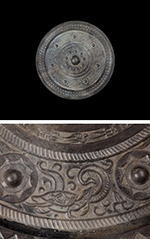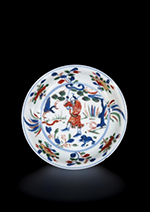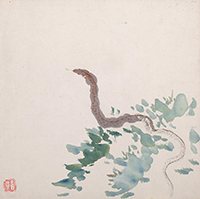
 I. Bronze mirror with animals of the four cardinal points I. Bronze mirror with animals of the four cardinal points
This bronze mirror, cast in the late Eastern Han Dynasty, has a spectacular decorative band on the back consisting of seven bosses and mythical creatures, including the four cardinal animals. The animal motifs, together with a narrow circular band of inscription, illustrate the Han people's popular belief in immortal land and the division of the heavens into four cardinal quarters, with a total of 28 constellations. Related to the theme of the snake is the xuanwu 玄武 which comprises the seven constellations in the northern quarter. Its visual representation is a snake intertwined with a tortoise. The xuanwu, together with the other three mythical animals—the green dragon of the east, the white tiger of the west and the vermilion bird of the south—are known as siling 四靈 or sishen 四神 and represent the four cardinal points, the heavens and even the cosmos—a popular belief that prevailed from the Warring States period to the Six Dynasties..  II. Dish with polychrome decoration of five poisonous creatures II. Dish with polychrome decoration of five poisonous creatures
This porcelain dish was produced in the imperial kiln of Emperor Wanli, during the Ming Dynasty. Painted in the central panel is the Daoist Heavenly Master Zhang holding a sword and surrounded by a snake, a toad and a scorpion. Five poisonous creatures are painted on the exterior: a snake, a scorpion, a centipede, a lizard and a toad. According to the book Zhuo zhong zhi by Liu Ruoyu (1584–ca.1642), a eunuch serving at the Wanli court, this dish was probably produced specially for use at the Wanli court during the Dragon Boat Festival. In addition to the five poisonous creatures, the calamus—an auspicious plant often used on such occasions—is also depicted on the dish. These decorative motifs are evidence of the rituals practiced in the Ming court. III. Ju Lian Snake (1828-1904)  This painting is from an album of 12 sheets of animals by the Guangdong painter Ju Lian (1828–1904). Painted in a simple composition with sparse strokes mainly in colour, Ju skillfully commands his innovative technique of washes with "fusing water" and "fusing colour", producing subtle colours in changing tones. The painting captures a lively image of the snake, testifying to the keen eye of the artist. This painting is from an album of 12 sheets of animals by the Guangdong painter Ju Lian (1828–1904). Painted in a simple composition with sparse strokes mainly in colour, Ju skillfully commands his innovative technique of washes with "fusing water" and "fusing colour", producing subtle colours in changing tones. The painting captures a lively image of the snake, testifying to the keen eye of the artist.
Ju Lian, a native of Panyu, Guangdong province, had a large number of students at his Shixiangyuan (Ten Fragrance Garden) studio, one of whom was Gao Jianfu who later became the founder of the Lingnan School of Painting. Gao may have inherited the practice of making sketches from Ju, and both had a creative spirit, as shown by this painting of the snake. |
















